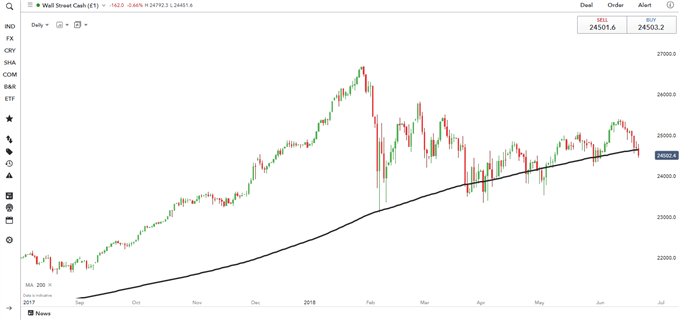Day Trading the Dow Jones Main Points:
- The Dow Jones Industrial Average is one of the oldest US stock indices, containing 30 of the largest US-based stocks traded on the New York Stock Exchange and the Nasdaq. The Dow is often called the ‘blue chip’ index because of the types of companies represented.
- Day traders will often look to US stock indices like the Dow Jones as prevailing market biases could make the prospect of short-term positioning a bit more clear. The Dow has been in a bull market now for more than nine years as of this writing, and that’s something that can help short-term traders glean a directional bias that can assist with day-to-day positioning.
The Dow Jones Industrial Average is the second-oldest stock index in existence, started in May of 1896 by Charles Dow and Edward Jones. Dow was an editor at the Wall Street Journal at the time, and his associate Edward Jones was a statistician looking for a simpler method of tracking market performance. The duo had created the Dow Jones Transportation Index in 1886 largely based around railroads, but as the US economy was becoming more industrialized they sought out a better way to gauge overall market performance and designed the Dow Jones Industrial Average around 30 industrial stocks. In the years since, the composition of the index has changed and that industrial connotation no longer applies as the index contains tech companies like Apple, IBM and Intel along with pharmaceutical companies like Merck and Pfizer.
Why Trade the Dow Jones and What Are the Main Trading Signals
As a result of the Dow Jones Industrial Average tracking 30 of the largest, most established companies in the US economy, the index remains attractive for those looking to focus on larger blue chip stocks. This can be attractive when trends display themselves across an asset class, such as we’ve seen over the past nine years in stocks out of the United States since the Global Financial Collapse. This can help traders glean a bias in a market, so that shorter-term day trading strategies can be focused in the direction of the prevailing trend.
One common way that traders measure or grade trends is with the 200 Day Moving Average. This is simply a 200-period moving average applied to the Daily chart, and when prices are above this level, traders can look at bullish strategies on shorter-term trading setups. Conversely, when prices cross-below this level, traders can then begin to look at bearish strategies under the expectation that prices may continue-lower.
Dow Jones Daily Chart via Wall Street Cash CFD

Chart created using IG charts
How to Day Trade the Dow Jones: The Importance of a Strategy
Day trading the Dow Jones is not simple, and most who try it fail. Day trading is about a lot more than just guessing which direction a stock or an index might move, and then hoping that that plays out. In the DailyFX Traits of Successful Traders research series, we looked at how risk management was an important determinant to one’s failure or success in the forex market, and this same type of rule can be applied to trading stocks or indices.
The future is uncertain, and this will always remain the case; the goal of the trader’s analysis is to simply get the odds on their side, even if only by a small amount. But losses will happen, and if left unchecked, one loss can wipe away the gains of numerous winning trades. So, while winning percentage is an important metric for a trader, it’s far from the only one, as things like risk-reward also play a key role in whether or not that trader will be able to survive the ups and downs of trading in financial markets.
As a general rule, traders should look to cut their losses short while letting their winners run, and this remains the case whether it’s a longer-term strategy, or a shorter-term day trading approach.
Dow Jones Trading Hours and Best Tips for Day Traders
US equity markets open at 9:30 AM and close at 4 PM Eastern Time, and this brings a more active period of trading for the Dow Jones Industrial Average and the constituents therein. This isn’t the only time that the index remains accessible, however, as the Dow Jones trading hours are available through futures contracts and CFD that remain open even when US markets are closed. Futures markets are open 23.25 hours per day, and CFD markets often mirror this; which allows traders to speculate on the Dow around-the-clock. The most liquid period of the day in the Dow is generally around US market hours, when both individual stocks and Exchange Traded Funds are trading along with related futures markets.
Trade management is a big point of emphasis for day traders. As we mentioned above, traders should look to cut losses short while letting winners run, and trade management can assist towards that end. Traders can look at trade management strategies such as break-even stops, or scaling out of a winning position in the effort of removing their initial risk outlay, while also affording the opportunity to exit from a profitable position at increasingly favorable rates.
Trading Dow Jones FAQ
Why is trade management more important that day trading signals?
At DailyFX, we researched millions of live trades to put research behind what our trading intuition has told us. That is to say when traders opened positions in the direction of strong trends with a positive risk to reward ratios, they had better chances of success on average. Risk to reward ratios are an important factor in distinguishing the traits of successful traders. Moving stop loss levels to break even as soon as practical is a method to achieving positive risk to reward ratios.






